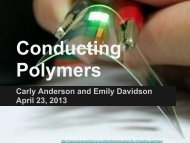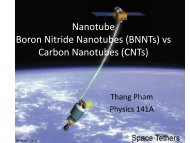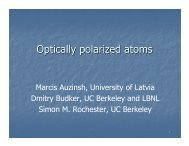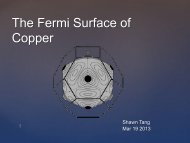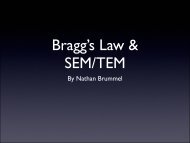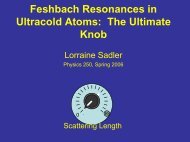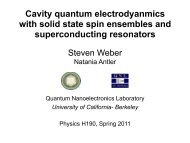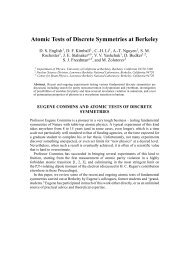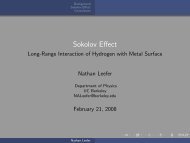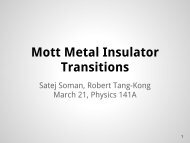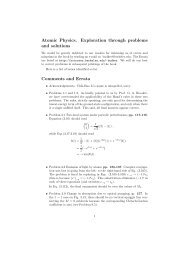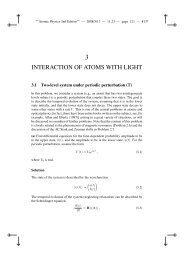Resonant nonlinear magneto-optical effects in atomsâ - The Budker ...
Resonant nonlinear magneto-optical effects in atomsâ - The Budker ...
Resonant nonlinear magneto-optical effects in atomsâ - The Budker ...
Create successful ePaper yourself
Turn your PDF publications into a flip-book with our unique Google optimized e-Paper software.
37<br />
to consider the photon shot-noise [Eq. (31)]. 33 Depend<strong>in</strong>g<br />
on the details of a particular measurement, either the<br />
sp<strong>in</strong> noise (33) or the photon noise (31) may dom<strong>in</strong>ate.<br />
If a measurement is optimized for statistical sensitivity,<br />
the two contributions to the noise are found to be comparable<br />
(<strong>Budker</strong> et al., 2000b).<br />
Fleischhauer et al. (2000) considered an additional<br />
source of noise <strong>in</strong> polarimetric sp<strong>in</strong> measurements. When<br />
the <strong>in</strong>put light is off-resonant, <strong>in</strong>dependent quantum fluctuations<br />
<strong>in</strong> <strong>in</strong>tensity of the two oppositely circularly polarized<br />
components of the light couple to the atomic Zeeman<br />
sublevels via ac Stark shifts and cause excess noise<br />
<strong>in</strong> the direction of the atomic sp<strong>in</strong>s. Fleischhauer et al.<br />
(2000) concluded that this source of noise, while negligible<br />
at low light power, actually dom<strong>in</strong>ates over the<br />
photon shot noise above a certa<strong>in</strong> critical power. Estimates<br />
based on the formulae derived by Fleischhauer<br />
et al. show that for the optimal conditions found by <strong>Budker</strong><br />
et al. (2000b) this effect could contribute to the overall<br />
noise at a level comparable to the photon shot noise.<br />
However, the effect of the ac Stark shifts can, <strong>in</strong> certa<strong>in</strong><br />
cases, be m<strong>in</strong>imized by tun<strong>in</strong>g the light frequency so that<br />
the shifts due to different off-resonance levels compensate<br />
each other (Novikova et al., 2001a). Some other possibilities<br />
for m<strong>in</strong>imiz<strong>in</strong>g the additional noise may <strong>in</strong>clude<br />
compensation of the effect by different atomic isotopes<br />
(Novikova et al., 2001a), or the use, <strong>in</strong>stead of a polarization<br />
rotation measurement, of another comb<strong>in</strong>ation of<br />
the Stokes parameters (Appendix A) chosen to maximize<br />
the signal-to-noise ratio.<br />
2. Experiments<br />
One approach to us<strong>in</strong>g NMOR for precision <strong>magneto</strong>metry<br />
is to take advantage of the ultra-narrow (width ∼1<br />
µG) resonance widths obta<strong>in</strong>able <strong>in</strong> paraff<strong>in</strong>-coated cells<br />
(Sec. VIII.E). Us<strong>in</strong>g the experimental setup described <strong>in</strong><br />
Sec. XI.A, <strong>Budker</strong> et al. (2000b) optimized the sensitivity<br />
of an NMOR-based <strong>magneto</strong>meter to sub-microgauss<br />
magnetic fields with respect to atomic density, light <strong>in</strong>tensity,<br />
and light frequency near the D1 and D2 l<strong>in</strong>es<br />
of 85 Rb. <strong>The</strong>y found that a shot-noise-limited <strong>magneto</strong>metric<br />
sensitivity of ∼3 × 10 −12 G Hz −1/2 was achievable<br />
<strong>in</strong> this system. This sensitivity was close to the shotnoise<br />
limit for an ideal measurement [Eq. (33)] with the<br />
given number of atoms <strong>in</strong> the vapor cell (∼10 12 at 20 ◦<br />
C and rate of ground state relaxation (∼1 Hz), <strong>in</strong>dicat<strong>in</strong>g<br />
that, <strong>in</strong> pr<strong>in</strong>ciple, NMOR is a nearly optimal technique<br />
for measur<strong>in</strong>g the precession of polarized atoms <strong>in</strong><br />
external fields. If limitations due to technical sources<br />
of noise can be overcome, the sensitivity of an NMORbased<br />
<strong>magneto</strong>meter may surpass that of current <strong>optical</strong><br />
pump<strong>in</strong>g (Alexandrov et al., 1996) and SQUID (superconduct<strong>in</strong>g<br />
quantum <strong>in</strong>terference device) <strong>magneto</strong>meters<br />
(Clarke, 1996), both of which operate near their shotnoise-limit,<br />
by an order of magnitude. Even higher sensitivities,<br />
up to 2 × 10 −14 G Hz −1/2 , may be achievable<br />
with an <strong>in</strong>genious <strong>magneto</strong>metric setup of Allred et al.<br />
(2002) <strong>in</strong> which K vapor at a density of 10 14 cm −3 is used<br />
and the effect of sp<strong>in</strong>-exchange relaxation is reduced by<br />
“lock<strong>in</strong>g” the precession of the two ground-state hyperf<strong>in</strong>e<br />
components together via the sp<strong>in</strong>-exchange collisions<br />
themselves (Happer and Tang, 1973).<br />
<strong>The</strong> magnetic-field dependence of NMOR is strongly<br />
affected by the magnitude and direction of transverse<br />
magnetic fields (<strong>Budker</strong> et al., 1998a,b). At low light<br />
powers, the transverse-field dependence can be quantitatively<br />
understood us<strong>in</strong>g a straightforward extension of<br />
the Kanorsky-Weis model discussed <strong>in</strong> Sec. VII.A, which<br />
opens the possibility of sensitive three-dimensional magnetic<br />
field measurements.<br />
As discussed <strong>in</strong> detail <strong>in</strong> Sec. XI.C, if frequencymodulated<br />
light is used to <strong>in</strong>duce and detect NMOR, the<br />
dynamic range of an NMOR-based <strong>magneto</strong>meter may be<br />
<strong>in</strong>creased beyond the microgauss range to > 1 G without<br />
appreciable loss of sensitivity.<br />
Novikova et al. (2001a); Novikova and Welch (2002),<br />
us<strong>in</strong>g buffer-gas-free uncoated cells, <strong>in</strong>vestigated the application<br />
of NMOR <strong>in</strong> <strong>optical</strong>ly thick media to <strong>magneto</strong>metry<br />
(Sec. VIII.A.3). Although the ultimate sensitivity<br />
that may be obta<strong>in</strong>ed with this method appears to<br />
be some two orders of magnitude <strong>in</strong>ferior to that obta<strong>in</strong>ed<br />
with paraff<strong>in</strong>-coated cells, 34 this method does provide a<br />
broad dynamic range, so that Earth-field (∼0.4 G) values<br />
could be measured with a standard polarimeter.<br />
Rochester and <strong>Budker</strong> (2002) theoretically analyzed<br />
<strong>magneto</strong>metric sensitivity of thick medium NMOR measurements<br />
optimized with respect to light <strong>in</strong>tensity <strong>in</strong> the<br />
case of negligible Doppler broaden<strong>in</strong>g, and <strong>in</strong> the case of<br />
large Doppler broaden<strong>in</strong>g. In the former case, the sensitivity<br />
improves as the square root of <strong>optical</strong> density,<br />
while <strong>in</strong> the latter, it improves l<strong>in</strong>early—a result which<br />
can be obta<strong>in</strong>ed from standard-quantum-limit considerations<br />
(Sec. XII.A.1).<br />
Cold atoms prepared by laser trapp<strong>in</strong>g and cool<strong>in</strong>g<br />
were also recently used for NMOR-based <strong>magneto</strong>metry.<br />
Isayama et al. (1999) employed a pump/probe geometry<br />
with ∼10 8 cold 85 Rb atoms that were trapped <strong>in</strong> a MOT<br />
and then released (Sec. VIII.H) for measurement of an<br />
applied magnetic field of ∼2 mG. <strong>The</strong> observation time<br />
for a s<strong>in</strong>gle measurement was limited to about 10 ms due<br />
to the free fall of the atoms <strong>in</strong> the Earth’s gravitational<br />
33 We do not consider the use of the so-called sp<strong>in</strong>-squeezed quantum<br />
states (discussed by, for example, Ulam-Orgikh and Kitagawa,<br />
2001, and references there<strong>in</strong>) or squeezed states of light<br />
(Grangier et al., 1987), which can allow sensitivity beyond the<br />
standard quantum limit.<br />
34 <strong>The</strong> limitation <strong>in</strong> practical realizations of thick-medium <strong>magneto</strong>metry<br />
may come from the <strong>effects</strong> of radiation trapp<strong>in</strong>g (Matsko<br />
et al., 2001b, 2002a; Novikova and Welch, 2002).



